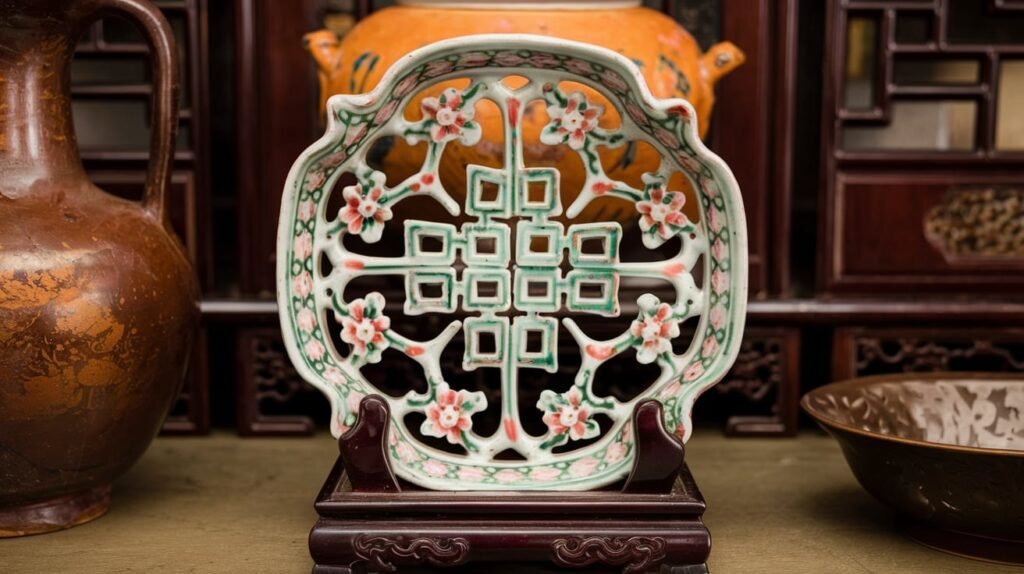A Glimpse Into Chinese Artistry
Chinese porcelain has long been revered in the world of fine art and antiques. Among these treasures, the antique Chinese porcelain quatrefoil brush washer stands as a unique artifact that captures the artistry and cultural richness of its time. This exquisite item reflects the sophistication and creativity of ancient Chinese craftsmen, who combined functionality with beauty.
Understanding the Quatrefoil Shape
The term “quatrefoil” refers to a symmetrical design consisting of four lobes or petals, resembling a clover or flower. This design has been a popular motif in Chinese decorative arts. The antique Chinese porcelain quatrefoil brush washer, with its elegant shape, not only served as a practical tool for scholars and calligraphers but also as a testament to their refined tastes.
The Role of Brush Washers in Chinese Culture
In traditional Chinese culture, brush washers were essential tools for scholars and artists. Used to clean brushes during calligraphy and painting, these items were crafted with great care. The antique Chinese porcelain quatrefoil brush washer often featured intricate designs, such as floral patterns, mythical creatures, or landscapes, which added a touch of artistic flair to its utilitarian purpose.
Materials and Techniques
The creation of an antique Chinese porcelain quatrefoil brush washer required exceptional skill. Porcelain, a material perfected in ancient China, was fired at high temperatures to achieve its characteristic translucence and durability. Craftsmen employed techniques such as underglaze painting and overglaze enameling to decorate these brush washers, ensuring each piece was both functional and visually captivating.
Historical Significance
The antique Chinese porcelain quatrefoil brush washer dates back to various Chinese dynasties, such as the Ming and Qing periods. During these times, brush washers became an integral part of the scholar’s desk, symbolizing intellect and aesthetic appreciation. The quatrefoil shape, in particular, was a favored design among the literati for its harmonious proportions and symbolic connection to nature.
Symbolism in Chinese Art
Chinese art is rich in symbolism, and the antique Chinese porcelain quatrefoil brush washer is no exception. The quatrefoil design is associated with balance, harmony, and prosperity. The motifs often depicted on these pieces, such as peonies, dragons, or phoenixes, carried auspicious meanings, making them cherished possessions and ideal gifts.
Collecting Antique Brush Washers
The antique Chinese porcelain quatrefoil brush washer is a highly sought-after item among collectors of Asian antiques.. Collectors often look for features such as the quality of the porcelain, the intricacy of the design, and any maker’s marks or inscriptions that indicate its origin and age.
Famous Examples
Several notable examples of the antique Chinese porcelain quatrefoil brush washer are housed in museums and private collections around the world. These pieces often showcase exceptional craftsmanship and offer insights into the cultural and artistic trends of their respective eras.
Preserving the Legacy
Preserving an antique Chinese porcelain quatrefoil brush washer requires meticulous care. Exposure to harsh conditions or improper handling can cause damage to the delicate porcelain. Collectors and enthusiasts must take measures to maintain these artifacts, ensuring their beauty and historical significance endure for future generations.
The Modern Appeal
Despite its ancient origins, the antique Chinese porcelain quatrefoil brush washer continues to captivate modern audiences. Its timeless design and cultural heritage make it a standout piece in any collection, bridging the gap between past and present.
Conclusion
The antique Chinese porcelain quatrefoil brush washer is more than just a functional object; it is a work of art, a cultural artifact, and a symbol of Chinese heritage. Its elegant design, historical significance, and enduring appeal make it a prized possession for collectors and an invaluable link to the past. By appreciating and preserving these exquisite pieces, we honor the craftsmanship and creativity of ancient China.

